| dc.contributor.author | Bektaş, Yusuf | |
| dc.contributor.author | Aksu, İsmail | |
| dc.contributor.author | Kalaycı, Gökhan | |
| dc.contributor.author | Irmak, Erhan | |
| dc.contributor.author | Engin, Semih | |
| dc.contributor.author | Turan, Davut | |
| dc.date.accessioned | 2020-12-19T20:41:52Z | |
| dc.date.available | 2020-12-19T20:41:52Z | |
| dc.date.issued | 2018 | |
| dc.identifier.citation | Bektaş, Y., Aksu, i., Kalaycı, İ., Irmak, E., Engin, S. & Turan, D. (2018). Genetic Differentiation of Three Spicara (Pisces: Centracanthidae) Species, S. maena, S. flexuosa and S. smaris: and Intraspecific Substructure of S. flexuosa in Turkish Coastal Waters. Turkish Journal of Fisheries and Aquatic Sciences, 18(2), 301-311. https://doi.org/10.4194/1303-2712-v18_2_09 | en_US |
| dc.identifier.issn | 1303-2712 | |
| dc.identifier.issn | 2149-181X | |
| dc.identifier.uri | https://doi.org/10.4194/1303-2712-v18_2_09 | |
| dc.identifier.uri | https://app.trdizin.gov.tr/makale/TXpVd09ERTNOdz09 | |
| dc.identifier.uri | https://hdl.handle.net/11436/5597 | |
| dc.description.abstract | Interspecific and intraspecific differentiation of the picarel in Turkish coastal waters were examined using partial 16S rRNA (1021 bp) and whole cytochrome b gene (1141 bp) sequences of 244 samples from 7 picarel populations across their geographical distribution. Genetic distances and phylogenetic tree topologies revealed that three Spicara species were distinctly separated from each other and S. flexuosa and S. maena are genetically more closely related than S. smaris. Lowlevel genetic diversity and a star-like haplotype network can be attributed to the founder effect associated with demographic bottleneck in late Pleistocene Mediterranean basin. AMOVA of the genetic substructure for S. flexuosa does not support any grouping in the Turkish waters. The divergence time between the Mediterranean and Black Sea populations (0.015%, cyt b) of S. flexuosa estimated based on the mtDNA clock calibration of 2% sequence per million years suggests that the Mediterranean samples with reduced genetic diversity has colonized into the Black Sea through straits during the early Holocene (about 7500 kya). The current distribution and demographic pattern of Spicara species in the Eastern Mediterranean basin are shaped by climatic events during late Pleistocene and mid-Holocene (about 25-5 kya) and the biological and ecological characteristics specific to Spicara species. | en_US |
| dc.language.iso | eng | en_US |
| dc.rights | info:eu-repo/semantics/openAccess | en_US |
| dc.title | Genetic differentiation of three spicara (Pisces: Centracanthidae) species, S. maena, S. flexuosa and S. smaris: and intraspecific substructure of S. flexuosa in Turkish coastal waters | en_US |
| dc.type | article | en_US |
| dc.contributor.department | RTEÜ, Su Ürünleri Fakültesi, Su Ürünleri Temel Bilimler Bölümü | en_US |
| dc.contributor.institutionauthor | Bektaş, Yusuf | |
| dc.contributor.institutionauthor | Aksu, İsmail | |
| dc.contributor.institutionauthor | Kalaycı, Gökhan | |
| dc.contributor.institutionauthor | Turan, Davut | |
| dc.identifier.doi | 10.4194/1303-2712-v18_2_09 | |
| dc.identifier.volume | 18 | en_US |
| dc.identifier.issue | 2 | en_US |
| dc.identifier.startpage | 301 | en_US |
| dc.identifier.endpage | 311 | en_US |
| dc.ri.edit | oa | en_US |
| dc.relation.journal | Turkish Journal of Fisheries and Aquatic Sciences | en_US |
| dc.relation.publicationcategory | Makale - Uluslararası Hakemli Dergi - Kurum Öğretim Elemanı | en_US |


















